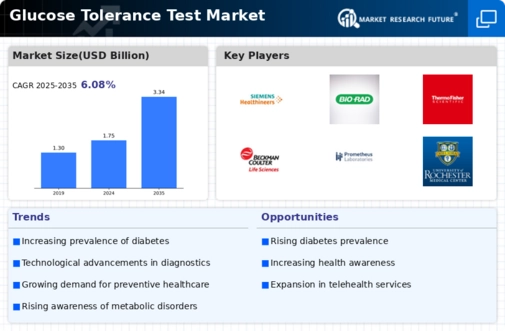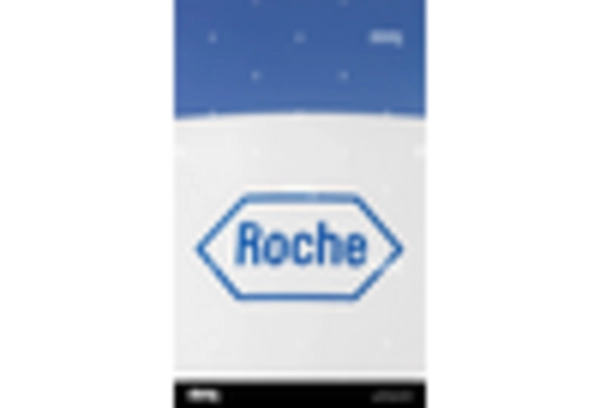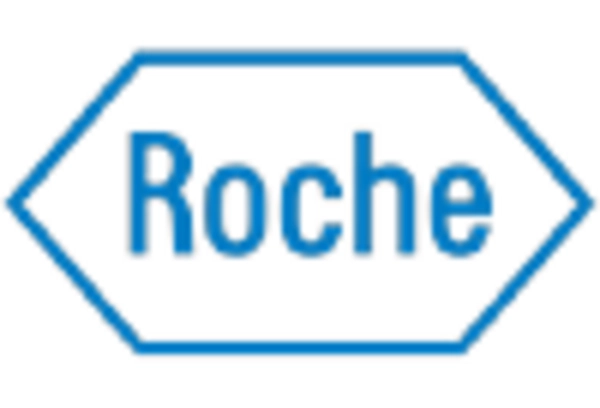Market Trends
Key Emerging Trends in the Glucose Tolerance Test Market
The glucose tolerance test (GTT) market has seen significant trends and developments in recent years, reflecting changes in healthcare practices, advancements in diagnostic technologies, and evolving patient needs. One notable trend is the increasing prevalence of diabetes and prediabetes worldwide, driven by factors such as sedentary lifestyles, unhealthy diets, and aging populations. As the incidence of diabetes continues to rise, there is a growing demand for accurate and reliable diagnostic tests such as the GTT to identify individuals at risk and facilitate early intervention and management. This trend is driving market growth in the GTT segment as healthcare providers seek to meet the growing demand for diabetes screening and diagnosis.
Furthermore, there is a growing emphasis on personalized medicine and precision diagnostics in the management of diabetes and metabolic disorders, driving the adoption of advanced GTT techniques and protocols tailored to individual patient needs. Traditional GTT methods involve administering a standardized glucose load and measuring blood glucose levels at specific time intervals to assess glucose tolerance and insulin sensitivity. However, there is increasing interest in alternative GTT protocols such as the oral glucose tolerance test (OGTT), intravenous glucose tolerance test (IVGTT), and mixed meal tolerance test (MMTT), which offer insights into different aspects of glucose metabolism and insulin secretion. These advanced GTT techniques enable more comprehensive assessment of metabolic function and facilitate targeted interventions to optimize glycemic control and prevent diabetes-related complications.
Moreover, technological advancements in glucose monitoring devices and continuous glucose monitoring (CGM) systems are driving innovation in the GTT market, enabling real-time monitoring of glucose levels and dynamic assessment of glucose tolerance profiles. CGM systems provide continuous glucose data over extended periods, allowing for detailed analysis of glucose variability, postprandial excursions, and nocturnal glycemia patterns. Integration of CGM data with GTT results offers a holistic view of glucose metabolism and insulin dynamics, guiding personalized treatment strategies and lifestyle interventions for individuals with impaired glucose tolerance and diabetes. Additionally, advancements in wearable glucose sensors and smartphone-based glucose monitoring apps enhance patient convenience and engagement in self-management of diabetes.
Additionally, there is a trend towards the development of point-of-care (POC) GTT devices and rapid diagnostic tests for convenient and timely screening of diabetes and prediabetes in primary care settings. POC GTT devices offer advantages such as rapid results, minimal sample volume requirements, and ease of use, making them suitable for use in community health centers, pharmacies, and mobile clinics. These POC GTT devices enable early detection of glucose abnormalities, facilitate prompt referral to specialized care providers, and empower patients to take proactive steps towards lifestyle modifications and disease prevention. Furthermore, integration of POC GTT devices with electronic health record (EHR) systems enables seamless documentation and tracking of screening results, supporting population health management initiatives and quality improvement efforts in diabetes care.
Furthermore, the GTT market is witnessing expansion opportunities in emerging markets and developing regions, driven by rising awareness of diabetes, increasing healthcare infrastructure, and growing investment in preventive healthcare initiatives. Governments, healthcare providers, and industry stakeholders are collaborating to improve access to diagnostic services, diabetes education, and lifestyle interventions for individuals at risk of diabetes and prediabetes. Market players are expanding their presence in emerging markets, introducing affordable GTT solutions, and implementing community-based screening programs to address unmet needs and reduce the burden of diabetes on healthcare systems.

















Leave a Comment